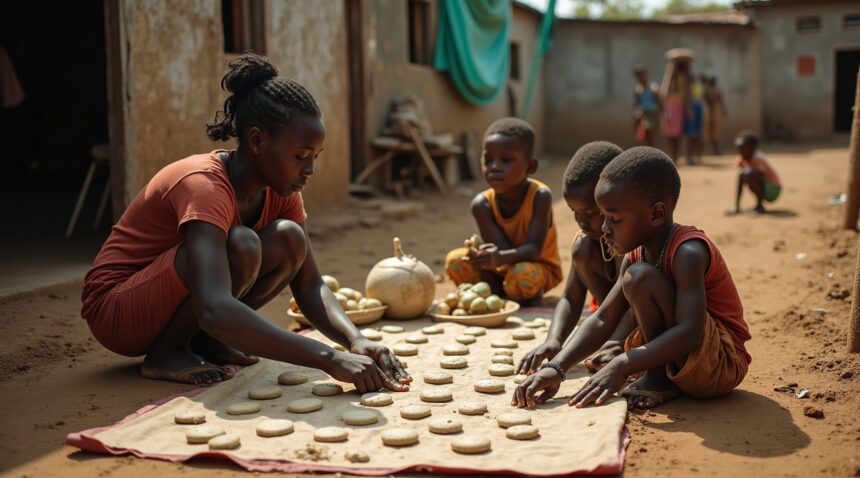In Haiti’s most impoverished communities, mud cookies known as bonbon te have tragically become a symbol of extreme hunger, offering momentary relief in the midst of overwhelming poverty.
Key Takeaways
- Mud cookies cost only 5 cents each, making them accessible to families living on less than a dollar per day when basic foods like rice become unaffordable.
- 84% of Haiti’s population cannot afford healthy food, with 5.4 million people experiencing acute food insecurity that drives desperate survival measures.
- The cookies are made from strained clay mixed with salt, oil, and sugar, then sun-dried into hard discs that provide minimal nutrition but temporarily fill empty stomachs.
- Serious health risks include tooth decay, intestinal blockages, parasites, and lead poisoning, yet families continue consumption due to immediate hunger needs outweighing long-term health concerns.
- Deep social stigma surrounds mud cookie consumption, marking families as having reached absolute economic despair and creating additional psychological burdens beyond physical hunger.
While mud cookies provide no substantial nourishment, their widespread use highlights the severe lack of food accessibility in Haiti. Global food inflation, political instability, and environmental disasters have only worsened the situation, forcing many families into these desperate measures. To learn more about Haiti’s food crisis and ways to help, organizations such as World Food Programme provide detailed reports and donation options aimed at alleviating hunger in the region.
When Dirt Becomes Food: How Haitians Survive on Mud Cookies for 5 Cents Each
In Haiti’s most impoverished neighborhoods, a desperate solution has emerged for families facing starvation. Mud cookies, known locally as bonbon te, represent the harsh reality of food insecurity that grips the poorest areas of this Caribbean nation. These small, flat discs made primarily from dirt have become a last resort for survival when traditional food sources remain financially out of reach.
The slums of Cite Soleil and shanty towns like Fort Dimanche witness the daily consumption of these unusual cookies. Families who can’t afford basic staples like rice turn to bonbon te as a way to fill empty stomachs and stave off the gnawing pain of hunger. While these cookies provide minimal nutritional value, they serve a crucial psychological and physical function by creating a feeling of fullness that temporarily masks starvation.
The Economics of Desperation
The economics behind mud cookies reveal the devastating poverty that affects millions of Haitians. Each cookie costs approximately 5 cents, making them accessible even to those living on less than a dollar per day. For context, $5 USD can produce around 100 cookies, demonstrating how this famine food has become a vital economic lifeline for undernourished populations.
This pricing structure creates a tragic marketplace where dirt becomes a commodity. Street vendors sell these cookies alongside other goods, and families often allocate their meager resources between actual food and these hunger-suppressing alternatives. The low cost makes bonbon te an unfortunate but practical choice for parents desperate to silence their children’s cries of hunger.
Women in these communities often gather clay from specific locations, believing certain types of dirt offer better taste or texture. The clay gets mixed with salt, vegetable shortening, and sometimes sugar before being formed into small patties and dried in the sun. This process has become so normalized in certain areas that children grow up considering mud cookies a regular part of their diet.
The hunger crisis in Haiti has reached such proportions that consuming dirt no longer carries the social stigma it might elsewhere. Instead, it represents resourcefulness and survival instinct in the face of systemic poverty. Families share these cookies during meals, treating them as any other food item while knowing they’re eating earth to survive another day.
Medical professionals express serious concern about the long-term health effects of consuming clay regularly. The practice can lead to intestinal blockages, tooth damage, and malnutrition rates that spiral even further downward. However, for families facing immediate starvation, these future health risks seem less pressing than the immediate need to quiet hunger pangs.
International aid organizations working in Haiti often encounter families whose children have become accustomed to the taste and texture of mud cookies. Some children prefer them to actual food when it becomes available, highlighting how prolonged food insecurity can alter dietary preferences and eating behaviors.
The prevalence of bonbon te consumption serves as a stark indicator of Haiti’s broader economic challenges. When people resort to eating dirt to survive, it signals the complete breakdown of social safety nets and food distribution systems. These cookies become both a symptom of extreme poverty and a temporary bandage for families hanging onto survival by the thinnest of margins.
Local markets in the poorest areas maintain steady supplies of mud cookies, with vendors often selling them alongside vegetables and other goods. This normalization of dirt consumption reflects how communities adapt to extreme circumstances, creating informal economies around the most basic human need for sustenance.
For more context, you can watch a short documentary on Haiti’s mud cookies here:
https://www.youtube.com/watch?v=E1n5vZ1zqgE
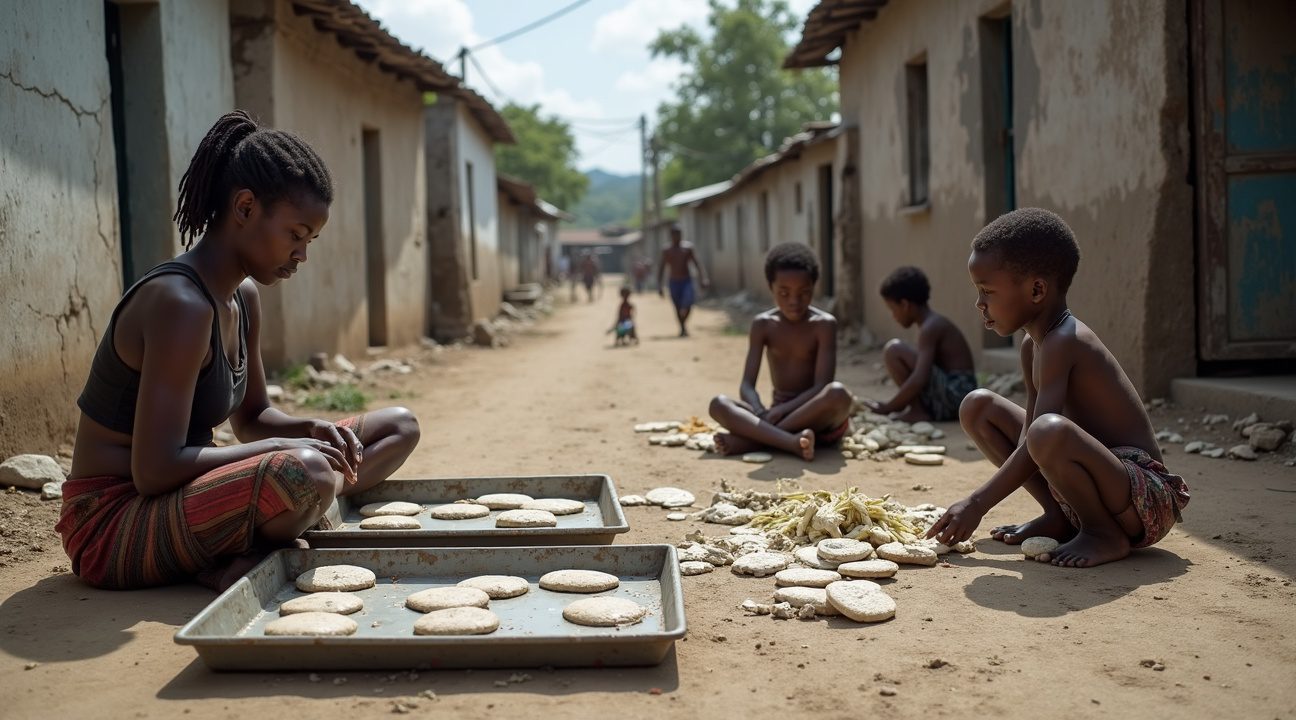
The Staggering Scale of Haiti’s Food Crisis in 2025
Haiti’s food crisis has reached catastrophic proportions, creating a humanitarian emergency that affects millions of people across the nation. Current data reveals that one in two Haitians suffers from undernourishment, representing a staggering half of the country’s population struggling to meet basic nutritional needs.
The economic barriers to adequate nutrition paint an even more dire picture. Nearly 84% of the population cannot afford healthy food, forcing families to make impossible choices between nutrition and survival. This widespread food insecurity stems from a combination of factors including soaring food prices, chronic unemployment, and the country’s heavy dependence on food imports that have become increasingly expensive.
Critical Hunger Statistics
The numbers behind Haiti’s food crisis demonstrate the urgent need for intervention:
- Acute food insecurity affects 5.4 million people, representing roughly half the population
- 6,000 individuals are experiencing conditions that approach famine-like severity
- 60% of Haitians live below the poverty line, lacking resources for adequate nutrition
- Up to 83% of households regularly skip meals or face uncertainty about their next meal
- Food import dependency leaves the country vulnerable to global price fluctuations
These statistics reflect a nation where hunger has become normalized, pushing families to adopt desperate survival strategies. Crop failures, exacerbated by climate challenges and political instability, have reduced domestic food production while import costs continue to rise. The combination creates a perfect storm where even basic sustenance becomes a luxury many cannot afford.
Migration patterns within Haiti show families abandoning rural areas where agricultural opportunities have disappeared, moving to urban centers that offer little relief. Port-au-Prince and other cities struggle to absorb these internal migrants, who often find themselves in overcrowded slums with even fewer resources than they left behind.
The unemployment crisis compounds these challenges, as job opportunities remain scarce across all sectors. Without steady income, families cannot maintain consistent access to food markets, even when basic commodities are available. This economic instability forces households into survival mode, where any available calories become precious regardless of nutritional value.
Food prices continue to outpace income growth, making even staple items like rice, beans, and cooking oil increasingly inaccessible. Import dependency means that global market fluctuations directly impact local food costs, creating additional volatility in an already unstable situation. Local farmers, who might otherwise provide domestic alternatives, face their own challenges with limited access to seeds, fertilizers, and reliable growing conditions.
The crisis affects children disproportionately, with malnutrition rates climbing as families struggle to provide adequate nutrition during critical developmental years. Schools that once provided meals for students have reduced or eliminated feeding programs due to budget constraints and supply chain disruptions.
Emergency food assistance reaches only a fraction of those in need, leaving vast populations to develop their own coping mechanisms. These include:
- Reducing meal frequency
- Consuming less nutritious foods
- Turning to non-traditional food sources that provide minimal nutritional value
The scale of this crisis extends beyond individual suffering to threaten Haiti’s social fabric and economic future. When such a large percentage of the population lacks basic nutrition, productivity declines, health systems become overwhelmed, and social tensions escalate. Children who experience chronic malnutrition face long-term developmental impacts that will affect Haiti’s human capital for generations.
Understanding these numbers provides crucial context for why desperate measures like mud cookies have emerged in the poorest communities. When 83% of households regularly skip meals and nearly 6,000 people face famine-like conditions, any substance that can fill an empty stomach becomes a consideration for survival.
What Drives Families to Eat Dirt: Economic Desperation and Rising Food Costs
Economic collapse has pushed countless Haitian families into an unthinkable reality where dirt becomes a food source. Food costs have skyrocketed by 2–5 times in recent years, transforming basic nutrition into an impossible luxury for the nation’s most vulnerable citizens. When families face this level of food price crisis, mud cookies represent their last resort against starvation.
The Harsh Mathematics of Survival
The numbers paint a devastating picture of daily survival in Haiti. In 2020, the average Haitian spent 35% of their income on a single meal, leaving families with impossible choices between eating and meeting other basic needs. This economic reality forces parents to search for alternatives that can fill empty stomachs when conventional food becomes financially unreachable.
Haiti’s import dependence creates additional vulnerabilities, as the country relies on imports for between 50% and 85% of its food supply. Inflation hits particularly hard when external economic shocks drive up the cost of imported goods, leaving local families at the mercy of global market fluctuations. Currency devaluation compounds these challenges, making foreign food imports even more expensive for households already operating on razor-thin budgets.
Infrastructure Barriers and Geographic Isolation
Beyond financial constraints, physical access to food presents another crushing barrier. Approximately 22% of the population must walk over an hour just to find groceries, turning food acquisition into a grueling daily expedition. Rural communities face especially severe challenges, with poor roads and limited transportation options creating geographic isolation that separates families from food markets.
Agricultural productivity remains stubbornly low despite Haiti’s agricultural heritage. Small-scale farmers struggle with degraded soil, limited access to quality seeds, inadequate irrigation systems, and outdated farming techniques. These factors combine to create local food shortages that drive prices even higher in domestic markets.
Natural disasters repeatedly devastate Haiti’s already fragile food systems. Hurricanes, earthquakes, and droughts destroy crops, disrupt supply chains, and force families deeper into food insecurity. Each disaster sets back agricultural recovery efforts and pushes more households toward desperate measures like consuming mud cookies.
Political instability and gang violence have created additional layers of food insecurity across the country. Armed groups control key transportation routes, making food distribution dangerous and expensive. Violence disrupts farming activities, forces people to abandon their land, and creates displacement that separates families from their traditional food sources.
Economic collapse has systematically dismantled the formal job market, leaving millions without reliable income streams. Unemployment and underemployment mean that even when food is available, families lack the purchasing power to afford adequate nutrition. Informal economic activities provide some income, but these rarely generate enough money to meet rising food costs.
Aid needs continue to grow as more families exhaust their coping mechanisms. International food assistance programs struggle to reach all those in need, creating gaps where families must find alternative solutions. Mud cookies emerge as a tragic adaptation to these circumstances, providing psychological comfort of “eating something” even when nutritional value remains minimal.
The convergence of these factors creates a perfect storm of food insecurity that pushes families toward consuming dirt. Import dependence makes Haiti vulnerable to external price shocks, while internal challenges like poor infrastructure and political violence limit local food production and distribution. Disaster vulnerability adds unpredictable disruptions that repeatedly set back progress toward food security.
This economic desperation transforms clay consumption from an unthinkable act into a rational survival strategy for families with no other options. Understanding these underlying drivers helps explain why mud cookies represent more than just poverty – they symbolize a systematic failure of economic and political systems to provide basic food security for Haiti’s most vulnerable citizens.
For more on this issue, you can explore Reuters’ coverage of Haiti’s food crisis.
Here is a video showing the reality of mud cookie production in Haiti:
https://www.youtube.com/watch?v=DqzZ7fzk6Ko
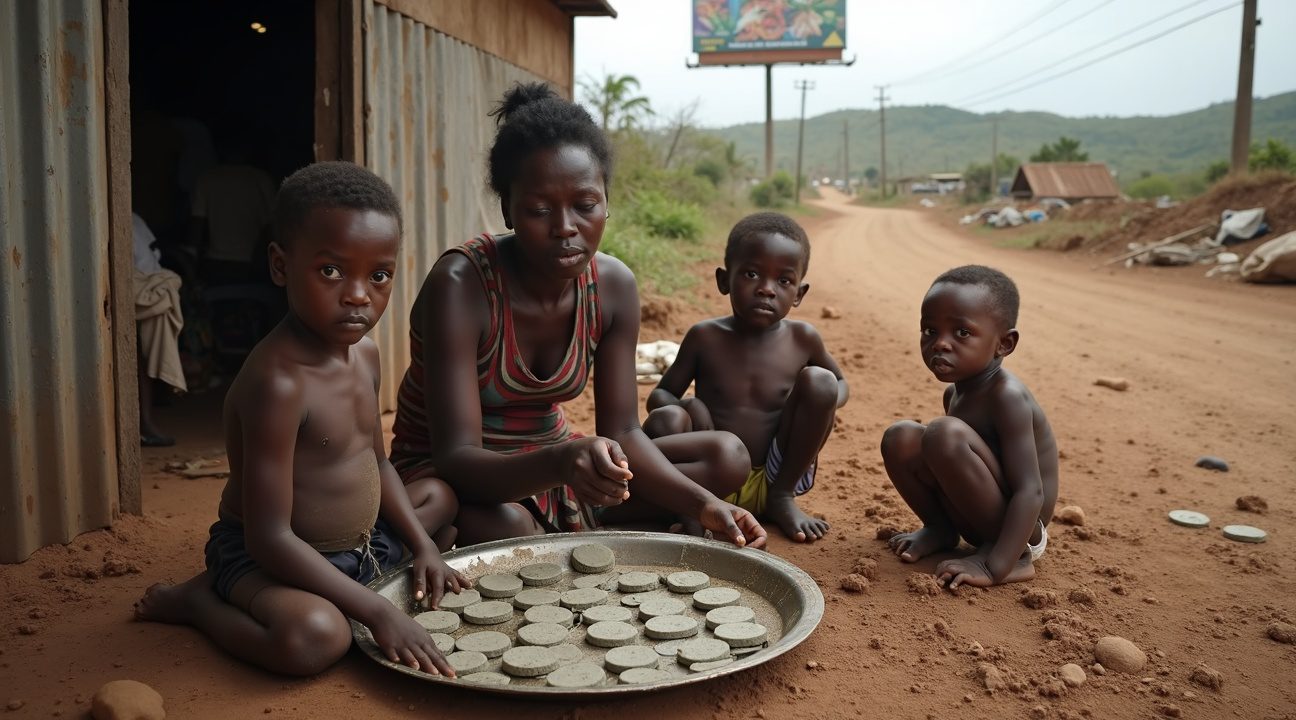
How Mud Cookies Are Made: From Clay to Dried Discs
The production of mud cookies follows a straightforward process that transforms basic clay into consumable discs. I’ve observed that these cookies represent one of humanity’s most desperate adaptations to extreme hunger, yet their creation requires specific techniques and ingredients to make them marginally safe for consumption.
Clay soil forms the foundation of mud cookie production, with the highest quality material sourced from Haiti’s Central Plateau near Hinche. This particular region provides clay that’s considered relatively clean compared to other areas. Producers carefully strain the raw clay to eliminate rocks, debris, and other potentially harmful materials that could damage teeth or cause internal injuries.
The Mixing and Shaping Process
After straining, the clay undergoes mixing with essential additives that make the final product more palatable and provide minimal nutritional value. The basic recipe includes:
- Salt, which adds flavor and helps bind the mixture
- Vegetable oil or shortening, providing small amounts of fat and calories
- Sugar, when available and affordable, to improve taste
- Clean water to achieve the proper consistency
The mixing process creates a moldable paste that producers shape into flat, round discs roughly the size of a small cookie. These discs require careful handling to maintain their shape while ensuring even thickness throughout. Uniformity helps guarantee consistent drying times and prevents cracking.
Sun-drying completes the production process, with the shaped discs laid out on clean surfaces under Haiti’s intense tropical sun. This drying phase typically takes several hours to a full day, depending on weather conditions and disc thickness. The finished product becomes hard and brittle, resembling actual cookies in appearance though lacking any real nutritional content.
La Saline market in Port-au-Prince serves as a major distribution hub for the clay used in mud cookie production. Vendors at this market sell bags of prepared clay soil, making the raw materials accessible to producers throughout the capital region. The market’s location makes it convenient for both rural suppliers bringing clay from places like Hinche and urban producers who lack access to quality clay sources.
This famine food costs significantly less than actual food items, making it accessible to Haiti’s most impoverished populations. While mud cookies provide virtually no nutritional benefit, they temporarily fill empty stomachs and may offer trace minerals from the clay. However, regular consumption can lead to serious health complications including intestinal blockages and malnutrition-related illnesses.
The entire production process reflects the devastating reality of extreme poverty, where people resort to consuming clay-based products simply to quiet hunger pangs. Each batch of dirt cookies represents both human ingenuity in survival situations and the tragic failure of systems meant to ensure basic food security.
https://www.youtube.com/watch?v=3zQWA4ssV3U
The Dangerous Health Reality Behind Traditional Beliefs
Traditional beliefs about mud cookies run deep in certain Haitian communities, where generations have passed down the practice of consuming these clay-based discs. Many believe these cookies provide essential calcium to the body and help reduce stomach acidity, making them particularly popular among pregnant women and children who face severe nutritional deficits.
Unfortunately, scientific evidence paints a starkly different picture. Health experts consistently warn that mud cookies offer virtually no nutritional value despite these long-held beliefs. The clay used in their production doesn’t contain bioavailable nutrients that the human body can effectively absorb or utilize for proper health maintenance.
Severe Health Consequences of Mud Cookie Consumption
The health risks associated with regular mud cookie consumption create serious medical concerns that extend far beyond simple malnutrition. Medical professionals have documented several dangerous side effects that affect consumers of all ages:
- Tooth decay occurs rapidly due to the abrasive nature of clay particles that wear down dental enamel
- Severe constipation develops as the digestive system struggles to process inorganic clay materials
- Intestinal worms and parasites frequently infect consumers through contaminated soil used in cookie production
- Lead poisoning poses a significant threat when clay sources contain heavy metal contamination
- Intestinal blockages can form when clay accumulates in the digestive tract over time
This practice falls under medical conditions known as pica and geophagia, which involve consuming non-food substances. While these behaviors sometimes stem from mineral deficiencies, the mud cookies don’t address the underlying nutritional needs that drive people to eat them in the first place.
Aid organizations working in Haiti have uncovered alarming statistics about childhood malnutrition in affected areas. Before receiving assistance, 85% of children in some programs showed signs of severe malnourishment, highlighting the desperate circumstances that drive families to rely on mud cookies as a food source.
Pregnant women face particularly acute risks when consuming these cookies regularly. The calcium they seek isn’t available in the clay, yet the consumption can interfere with proper nutrient absorption from other food sources. This creates a dangerous cycle where the very practice intended to address nutritional needs actually worsens the underlying health problems.
Medical experts emphasize that while tradition plays an important role in cultural identity, the health consequences of mud cookie consumption far outweigh any perceived benefits. The practice doesn’t address the root causes of hunger and malnutrition, instead creating additional health burdens for already vulnerable populations struggling with food insecurity.
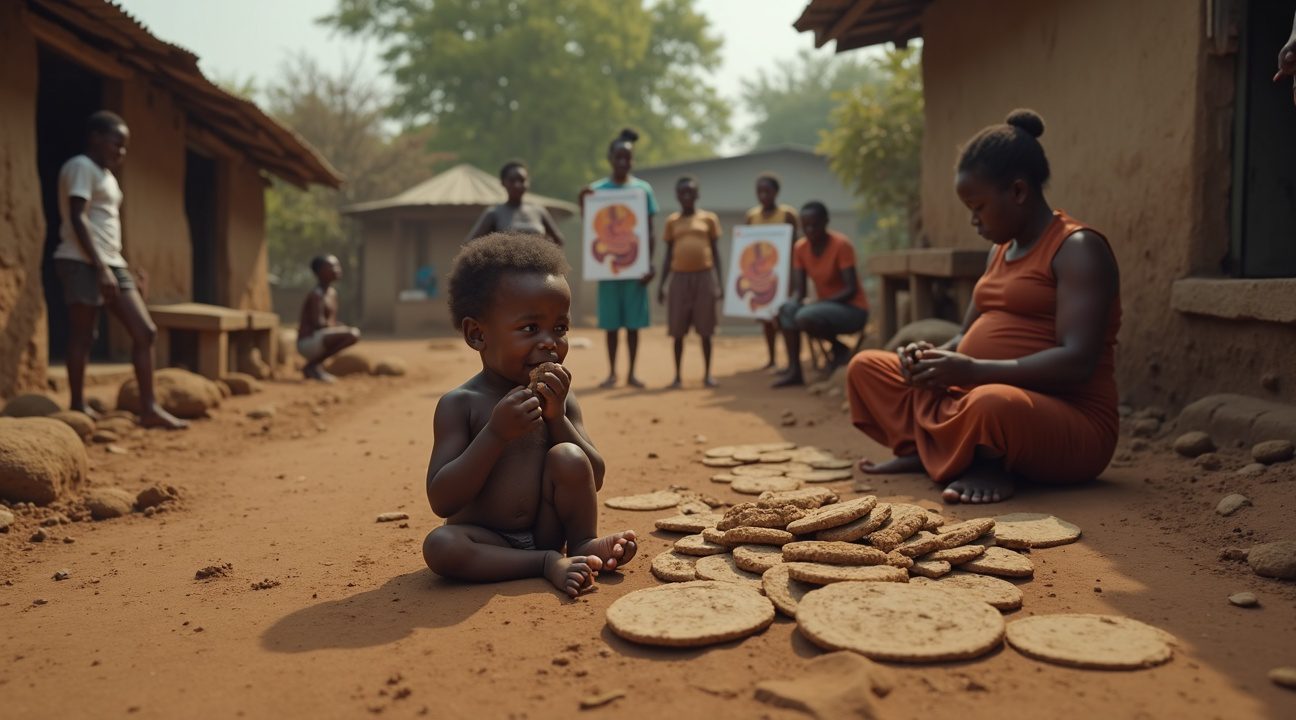
The Taste of Desperation: Living with the Stigma of Eating Dirt
The texture of mud cookies presents an immediate assault on the senses. They crumble with a smooth consistency that quickly absorbs moisture from the mouth, creating an uncomfortable dryness that’s difficult to overcome. The lingering taste of dirt remains long after consumption, serving as a constant reminder of the desperate circumstances that led to this meal.
Beyond the physical experience lies a deeper wound. Eating these clay discs carries profound social stigma within Haitian communities, marking families as having reached the absolute bottom of economic despair. Neighbors whisper when they see children carrying plates of the pale, round discs home from the market. Parents often try to hide their consumption from others, eating them behind closed doors or late at night when fewer people might witness their shame.
The Weight of Community Judgment
This famine food represents more than just sustenance—it’s become a visible symbol of failure in a society where dignity matters deeply. Families who resort to mud cookies face judgment from those who haven’t yet reached such desperate measures. Children eating them at school endure mockery from classmates whose families can still afford rice or beans. The psychological toll often proves as devastating as the physical hunger itself.
The stigma creates additional barriers for families already struggling. Some refuse to eat mud cookies even when facing starvation, choosing hunger over the social consequences. Others withdraw from community activities, isolating themselves to avoid the shame associated with their dietary choices. Women, who traditionally prepare meals, carry particular burden as they’re often blamed for the family’s inability to provide proper food.
Local health workers report that families frequently lie about consuming mud cookies during medical visits. They understand the health risks but fear the judgment that comes with admitting they’ve resorted to eating dirt. This secrecy prevents proper monitoring of nutritional deficiencies and delays necessary medical interventions.
The taste of desperation extends beyond the physical act of eating clay. It encompasses:
- The bitter reality of watching children ask for food that doesn’t exist
- The metallic tang of fear when deciding between rent money and groceries
- The sour aftermath of swallowing pride along with dirt
Each mud cookie consumed represents a small death of hope, a surrender to circumstances that no person should face.
Community leaders work to reduce the stigma while addressing its root causes. They emphasize that eating mud cookies reflects systemic poverty rather than personal failure. Educational programs help people understand that families making this choice aren’t lazy or irresponsible—they’re survivors doing whatever it takes to stay alive in impossible circumstances.
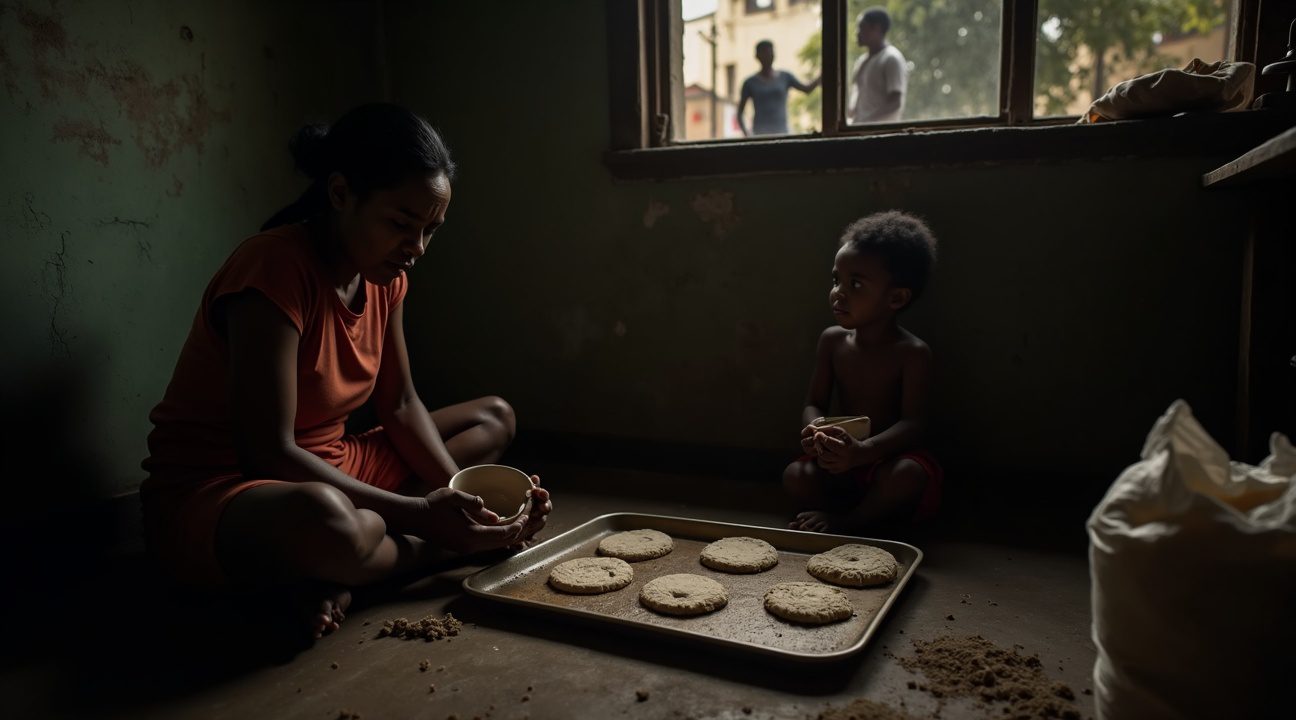
Sources:
World Food Prize Foundation – Malnutrition in Haiti
Statista – Poverty in Haiti – statistics & facts
Wikipedia – Mud cookie
IFAD – Haiti
Loving Shepherd Ministries – The Heartbreaking Reality of Mud Cookies
Concern Worldwide – The Haiti crisis, explained: What you need to know in 2025
Blessings of Hope – From Dirt Cookies to Real Meals: A Call to Help Haiti
World Bank – Haiti – Poverty and Inequality Platform

